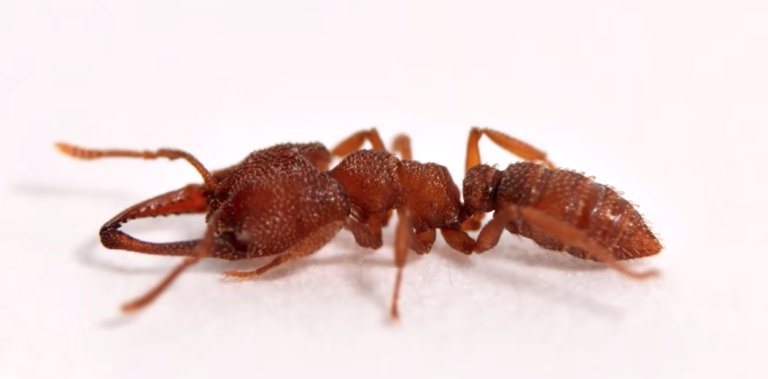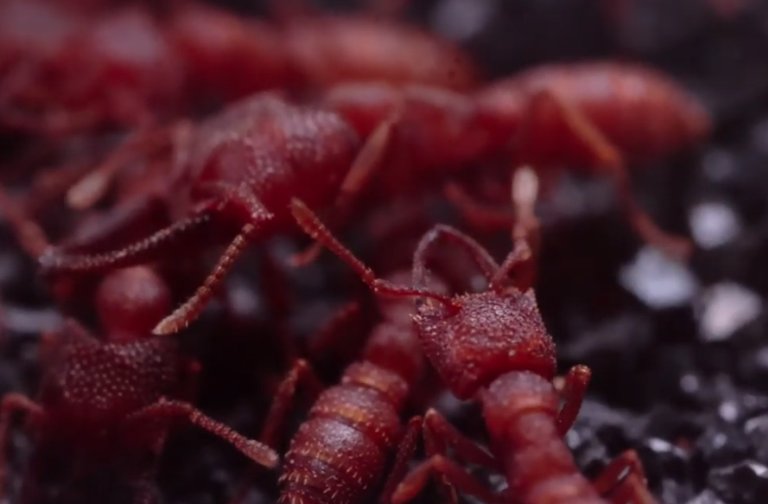Snap-jaw Ant Ant Profile
The hunt for the fastest animal alive brings with it many contenders. The cheetah is pretty quick at running, the peregrine falcon is quite good at falling out of the sky quickly, and the mantis shrimp can swing a fist at lightening speed; enough to smash through the glass of its aquarium and boil the surrounding water.
None of these animals has anything on today’s subject. The snap-jaw ant is up near the very top of the top when it comes to fastest moving animal, and are sometimes known as ‘Dracula ants’.

Snap-jaw Ant Facts Overview
| Habitat: | Rainforests |
| Location: | Africa, some in Eurasia |
| Lifespan: | Unknown |
| Size: | Typically less than 1cm |
| Weight: | >1g |
| Color: | Mostly reddish brown |
| Diet: | Invertebrates |
| Predators: | Larger arthropods, birds, and small mammals |
| Top Speed: | Slow, or 300mph |
| No. of Species: |
14 |
| Conservation Status: |
Not listed |
Snap-jaw ants are a rare genus of ants that contain one of the fastest-moving mechanisms in the animal kingdom. They use it for a variety of purposes and have plenty of backup options too.
There are 14 known species of snap-jaw ants in the genus Mystrium, all of which inhabit rainforests in tropical Africa, Southeast Asia and Australia. 10 of the species are only found in Madagascar.
They have some bizarre morphology and are into some pretty freaky cannibalistic rituals, which is why one species (Mystrium camillae), are more commonly known as ‘dracula ants’.
Take a look at these cool facts about one of the lesser-known and weirder genera of ants around.
Interesting Snap-jaw Ant Facts
1. They’re one of the fastest animals alive
It may seem weird to picture an ant at close to 400kmph (248mph), but this ant isn’t running this fast, so the land speed record is still intact. However, it does have the ability to close its jaws this fast, and for a short while, it was known as the fastest-moving animal motion on earth.
However, as we discover more about the elastic power-amplifying mechanisms that insects use, and have better access to high-end cameras and computer power, these titles begin to change hands quickly.
As of 2020, the new record holder is a termite, with a mandible that moves closer to 482kmph, or 300mph! Still, the speed of a snap-jaw ant is nothing to be scoffed at. 1
2. Their mandibles are spring-loaded
Insects are quite small, and being small means having small muscles. Small muscles come with small muscle force, and that puts a limitation on how fast and hard you can move something.
The fastest arthropods like these ants, and the termite, as well as springtails, mantis shrimps, and other snappy little things, overcome these limitations with a clever combination of springs and latches.
Slow muscles store up potential energy in these springs and hold it in place with a latch mechanism.
In some animals, these springs and latches are separate components, but the snap-jaw ant has taken its evolution one step further and incorporates the latch into the mandible itself.
This mandible is specially made for snapping, and it’s less stiff than an equivalent biting jaw, allowing them to deform to store tension.
Just like snapping fingers, some species push the tips of their mandibles together to load up the mechanism and release by allowing them to slide past one another. This creates both tremendous speed and acceleration and gives the ant its distinctive characteristic. 2
3. Their bite can even send them flying
The jaws on this ant serve a few purposes. They can be used for predation, defence, and for a rapid change of scenery!
Snap-jaw ants are so powerful that their snaps can send them flying off their leaf and off into the undergrowth at the first sign of danger.
4. They’re vampires
These ants are sometimes known as Dracula Ants because they have been known to suck on the innards of larvae. This would be creepy enough on its own, but the queens of these colonies are known to boost their nutrition by feasting on the juices of their own larvae.
This is a strange form of cannibal parasite behaviour may be what’s known as conspecific parasitism, on which there isn’t much literature outside of nesting birds.
As if it couldn’t get any worse, in some colonies, the queens can’t even do this themselves. The workers bite and scratch into the larvae, opening them up to suck on the haemolymph that’s released.
This is then fed to the queen through a horrifying regurgitation ritual. 3

5. They can also sting
If snapping at you and sucking your blood wasn’t enough, these ants also pack a punch at the back end.
Their venom is similar to other ant venom, and not considered to be medically significant, but can cause an allergic reaction in some.
6. They can play dead
Many species of Mystrium ant can lie motionless when disturbed, playing dead until the threat has passed. Sneaky!
7. They eat centipedes
There aren’t many arthropods brave enough to take on a centipede. Yet some species of snap-jaw ant have been known to predate upon them.
8. They have multiple fertile females
Something which is quite unusual in ants, certain species of snap-jaw produce an entire caste of reproductive females.
Most of these don’t leave the nest or mate and are content operating in a brood-care capacity. Other species have a single queen morph, who will either bud off from the group and found new nests or take half the nest with her and leave the remaining with a new queen.

9. They’re not to be confused with trap-jaw ants!
There’s another genus of snappy little ant critters that match many of the points in this article.
They snap, they sting, they’re also one of the fastest moving animals, and their common name even rhymes with snap-jaw. The trap-jaw ant is often used interchangeably online, but these are a different genus in the same family. The most obvious difference is the size – trap-jaws are larger – and the way their jaws work.
Snap-jaws push their mandibles together, as we have described, but trap-jaws ratchet theirs open to more than 180 degrees and lock them in place under pressure with a latch inside the head. This allows them to snap their jaws shut like a bear trap, hence the name.
Still, this can get confusing. Trap jaws have evolved independently in at least three families of ants, including the snap-jaw family Formicinae, which only complicates things.
10. They can have some very small colonies
These ants have been known to occupy tiny little nests under rocks and logs, and many colonies have as few as 200 individuals.
At the other end of the scale, driver ants can have colonies of up to 50 million ants.
Snap-jaw Ant Fact-File Summary
Scientific Classification
| Kingdom: | Animalia |
| Phylum: | Arthropoda |
| Class: | Insecta |
| Order: | Hymenoptera |
| Family: | Formicidae |
| Subfamily: | Amblyoponinae |
| Genus: |
Mystrium |
Fact Sources & References
- Kuan-Chih Kuan (2020), “Termite’s Twisted Mandible Presents Fast, Powerful, and Precise Strikes“, Nature.com.
- Fredrick J. Larabee (2018), “Snap-jaw morphology is specialized for high-speed power amplification in the Dracula ant, Mystrium camillae“, Royal Open Science.
- David Perlman (2001), “Discovery of Blood-Sucking Ant Species Scrambles Some Theories“, SF Gate.
